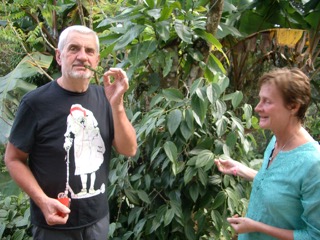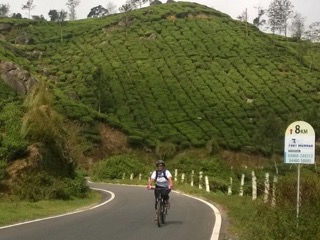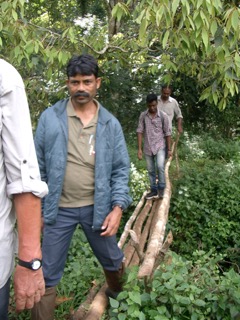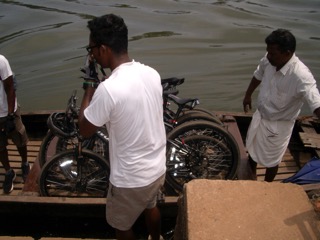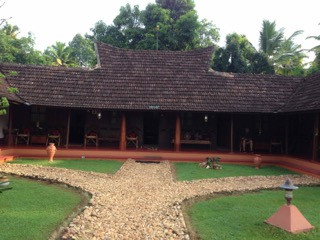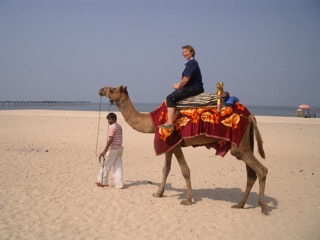 Midnight’s Children is an ambitious and sprawling film. Based on the celebrated 1981 Booker Prize-winning novel by Salman Rushdie and adapted by Rushdie himself, it is thoroughly enjoyable. It is visually stunning and allows itself time to tell it’s story.
Midnight’s Children is an ambitious and sprawling film. Based on the celebrated 1981 Booker Prize-winning novel by Salman Rushdie and adapted by Rushdie himself, it is thoroughly enjoyable. It is visually stunning and allows itself time to tell it’s story.
Filmed in Sri Lanka and spanning several decades, the film is something of a history lesson. The surrender of the Pakistani army and the subsequent creation of Bangladesh is filmed incredibly well. No overplaying of the situation and a good overtone of respect. Although I knew the history surrounding this time it was great to see it on screen. History is too often forgotten.
The film starts with Saleem telling how his grandparents met, then his parents, until we come to his birth on the stroke of midnight on the day of India’s new independence from the United Kingdom in 1947.
I loved that this film takes it’s time to really tell the story, but it is not filler, it has a good length. The actors are all brilliant and the film is beautifully shot. This film may be a history lesson, but it is an entertaining one. An ambitious film which has payed off.
Definitely one to watch.
“Born in the hour of India’s freedom. Handcuffed to history.”
Spanning decades and generations, celebrated Canadian filmmaker Deepa Mehta’s highly anticipated adaptation of Salman Rushdie’s Booker Prize®–winning novel is an engrossing allegorical fantasy in which children born on the cusp of India’s independence from Britain are endowed with strange, magical abilities.
Midnight’s Children follows the destinies of a pair of children born at the stroke of midnight on August 15, 1947, the very moment that India claimed its independence from Great Britain — a coincidence of profound consequence for both. “Handcuffed to history,” and switched at birth by a nurse in a Bombay hospital, Saleem Sinai (Satya Bhabha), the son of a poor single mother, and Shiva (Siddharth), scion of a wealthy family, are condemned to live out the fate intended for the other. Imbued with mysterious telepathic powers, their lives become strangely intertwined and inextricably linked to their country’s careening journey through the tumultuous twentieth century.
IN CINEMAS DECEMBER 26TH
INTERVIEW WITH DIRECTOR DEEPA MEHTA
Why this book? This story?
I first read Midnight’s Children in the winter of 1982 in Delhi. I distinctly remember talking about the wonder of it all with a friend while we walked around Lodhi Gardens. It had an enormous impact on me. It uncannily echoed my own upbringing, and for a novice filmmaker in the early ‘80s the book seemed to read like a movie – full of cinematic language and rooted in popular Indian cinema. The novel’s fearless dark humour combined with its affection for all human foibles stayed with me. Salman and I often talked about working together. One night, over dinner, I asked him who had the rights to Midnight’s Children. He said he did. I asked to buy them and he sold the option to me for one dollar. It was not premeditated; it was just gut instinct.
What is the movie about?
It is a coming-of-age story, full of the trials and tribulations of growing up, and of the terrible weight of expectations. What separates it from other similar thematic films is that this coming of age story is not only about a boy but also about his country, both of whom are born at the very same time at a pivotal point in Indian history. Saleem’s journey as our vulnerable, misguided hero is always intertwined with the struggles of the newly independent India, as it finds its own voice in the world.
Art by its very nature is political and I believe that Midnight’s Children says something important and universal about survival, freedom and hope.
Why this movie now, for you?
There is a saying – luck favours the prepared. The choices that I have embraced in life and the movies that I have made previously have certainly given me the technical and emotional confidence to tackle an epic about my homeland, but in many ways, I felt that I was learning the filmmaking craft all over again. My desire to make this film came from a gut instinct. I knew I wanted to do it but it required a huge amount of chutzpah to then wrap my head around actually filming it. I think that my producing partner David Hamilton’s dedication and leadership really did make it possible. Some of the most meaningful decisions in life are based on that indiscernible feeling of just knowing it’s time. And it was.
My core team: design, camera, wardrobe, editing were all available and wildly keen to work on Midnight’s Children, as was the wonderful ensemble cast. But I think the most vital factor of all is the pure delight and fun of working with Salman, and how profoundly in synch we are about the heart of the story. Salman and I have both made our homes in the Indian Diaspora; I in Canada, he in Britain and America, and we have similar complicated intertwined roots in India. Those shared perspectives and memories, plus his creative generosity and wit, kept me, and the movie, going. Salman once said, about Indian born artists who have emigrated, “ Our identity is at once plural and partial. Sometimes we feel that we straddle two cultures; at other times, that we fall between two stools. But however ambiguous and shifting the ground may be, it is not an infertile territory for a writer to occupy.”
Is this film a “love letter to India” from you?
Salman has often said that the book is his love letter to India. I hope the film reflects the same sentiment. The last lines are, “The truth has been less glorious than the dream. But we have survived and made our way. And our lives have been, in spite of everything, acts of love.” The story, in its detail, becomes universal in its message of love and redemption.
How did you and Salman work on the adaptation, and what are the key changes from the book?
After Salman sold us the option to the book, he agreed, reluctantly, to write the screenplay. The book is inherently visceral and cinematic; the problem is length. The novel is 533 pages long and first drafts of the script were 260 pages. Early on, at our most important script meeting, Salman and I both brought handwritten lists of the dramatic moments which absolutely had to be preserved. One might spot some karma or magic at work here – our lists matched, in almost every way. The ruthless surgical decisions about cutting had to be Salman’s alone: whole swathes of story and characters – gone. And then the intricate balance of what to shape, change, or add was our shared task. I suggested scenes, moments, emotions. Drafts went back and forth as they do. Painful cuts continued to be made right up to shooting and also in the cutting room. We preserved and protected the central thread of the story and tied it always to Saleem.
The biggest changes from the book are that Saleem and Shiva are now inextricably linked throughout and Shiva is given greater prominence; the story builds towards the Saleem-Parvati- Shiva triangle. Recalibrating and reshaping the last scenes during the Emergency and afterwards are important shifts, but it would ruin the ending to say anything further about those specific changes. We also deleted the overall narrator (from the novel), and in its place Salman wrote a spare, precise, evocative voiceover, which he performs – wonderfully.
How did you prepare for Midnight’s Children?
I have the terrible reputation of spending my down time not moving unless I have to. Devyani, my daughter, has often said that her mum’s favourite exercise is “turning the page of a book”! Well, a slight exaggeration but somewhat true. All that changed about six months after Midnight’s Children was green lit. I found an empathic, encouraging trainer and went to the gym every day (reluctantly!) before production. I felt I needed every bit of stamina and awareness, and this physical preparation was perhaps the most essential of all. This film, more than most, because of its sheer scope was going to need not just my focus but also my stamina. The wisest decision I made.
Preparation with the cast is a given. A month before shooting there was an intensive workshop in Mumbai with the actors and me, led by my friend Neelam Choudhry, a theatre director from Chandigarh. This was not a rehearsal of the script; it was work based on the Natya Shastra, a treatise written in India in the 4th century AD about the art of drama, which includes a rasabox or grid of nine essential mental states and emotions: love, repulsion, bravery, cowardice, humour, eroticism, wonderment, compassion, and peace. This intensive work knitted us together as a group and grounded us in the emotional arcs of the film.
I don’t use shot lists or storyboards; the actor motivates my camera. From the actors I know what the emotional centre of the scene will be and then we shoot it. By now my long time DOP Giles Nuttgens and I have a finely honed shorthand.
But the most important preparation (except perhaps for the gym!) was meticulously planning the world of the movie. In Midnight’s Children we meet four generations over five very distinct time periods; there are three wars, 64 locations, and 127 speaking parts, plus animals, babies, snakes, cockroaches [Well, that didn’t really work out. Our cockroach wrangler failed]. And everything in the world of the film had to be shipped or found or designed or built in Sri Lanka. My closest ally and second brain/eyes is always my brother Dilip, who is responsible for the entire “look” of this film. He fought for authenticity in every aspect of the movie: visuals, historical period, class, accents, religious backgrounds…no detail too large (wars, helicopters, parades) or too small (ants, lizards) to escape his scrutiny. There is no one else whom I fully trust who knows the historical landscape and the “real” India, and who could create all of this flawlessly and with such a passion for accuracy and for beauty.
Did you have any filmmaking touchstones or influences as you planned the shooting of Midnight’s Children?
During the script process I thought a lot about classic elegant films like The Leopard, which is also a historical/political film. As we got closer to shooting Midnight’s Children and I got more inside the script and the energy needed to keep the story going, I began to think about movies like The Conformist – movies with tougher and more immediate storytelling. All along Giles and I planned on a traditional camera department, and many extra tracks and dollies had been shipped to Sri Lanka. A week before shooting I realized that we had to ramp up the energy of the movie, keep constantly moving psychologically, always have a sense of immediacy and fluidity, and free ourselves from time consuming set ups. There was just too much to cover. So we ditched most of the equipment and Giles shot almost the entire movie handheld, up close, intimate, and full of energy. This was a major liberation for all of us, especially because I do all of my blocking with the actors right on set.
How did you want to deal with the magic or magic realism elements?
I always wanted to show the fabulist as realism. I never wanted masses of CGI and visual effects; there are some effects in the movie, but pretty minimal. I wanted the fantastical elements to be grounded in reality. Salman has described the Children as “gifted or cursed with telepathy”. It’s up to audiences to draw their own conclusions about Saleem’s experiences, his loneliness, his vivid imagination and the Children’s corporeal reality.
The movie intentionally plays around with time shifts, foreshadowing, dreams and witchcraft. The most significant magical item is probably Parvati’s basket of invisibility, yet it is used in very practical and credible ways. Or at least Picture Singh believes so…and magicians are the last to believe in real magic. For me the film magically changes the definition of family. By the end of the movie, Saleem’s concept of family (and perhaps ours) is truly transformed.
How did you pull all the aspects of this complex story together in the edit?
When we came back from the shoot my editor Colin Monie and I knew Midnight’s Children had to be constructed in stages, and that we had to get each stage right before we moved on. These stages were:
1) The flesh and blood: Saleem and the character/family saga stories had to be shaped first;
2) Then the history-wars-time periods had to work within the overall story and be clear;
3) Then the theme, politics and what the film says about India, had to be woven in
…and that actually is how the movie came together: cut by cut, screening by screening. From intimate personal story – to family saga – to epic.
We protected the personal, the intimate, and the emotional core of all the characters inside this roomy canvas, full of disasters, wars and shattering events. That was not always easy, nor was figuring out how much of the history and politics to include. This is a movie for audiences all around the world who will have very differing amounts of knowledge about India and we did not want to over explain, or under explain.
Deepa Mehta
****************************************************************************
“ON T H E M A K I N G O F M I D N I G H T ’ S C H I L D R E N ” SALMAN RUSHDIE
Deepa Mehta and I agreed to work together to make a film of Midnight’s Children on June 9th, 2008. I was passing through Toronto on the North American publication tour for The Enchantress of Florence and had dinner with Deepa on my one free evening. She asked me who had the rights to Midnight’s Children; I replied that I did; she asked me if she could film it; I said yes. It was as simple as that.
Four and a quarter years later, the film of the “book that was impossible to film” is finally finished, and I’ve had quite an education in what it actually takes to get a film made. I’ve learned, for example, that when some potential financial backers tell you that they totally adore your book, they 100% love your script, they worship Deepa, and they are totally committed to helping us get our film made, this is what they mean: “Hello.”
Over the years, before Deepa, David Hamilton and I started on our journey together, more than one attempt to film Midnight’s Children had foundered. There are so many ways a film can fail to get made. Consequently, I’ve developed a great respect for anyone who gets any film made and puts it out there. I’ve also come to feel – and I am not ordinarily a superstitious or mystically inclined individual – that it was right that those earlier attempts to film my book failed, so that this one could succeed. One might almost use the word “karma.”
I’m happy that we were able to retain complete creative control of the project and to make the film that Deepa and I wanted to make. Nobody told us how to write it, cast it, shoot it or cut it, so there’s nobody else to blame, and that’s exactly the way we both wanted it to be.
Years earlier, Hanif Kureishi had told me of his happy collaboration with Stephen Frears on My Beautiful Laundrette, and Paul Auster had said much the same about working with Wayne Wang on Smoke and Blue in the Face. I had long hoped that I might some day encounter a filmmaker with whom I could have such a close, happy, fruitful working relationship. Deepa Mehta was the answer to that dream.
From our first script meeting, we found we were almost uncannily of one mind about how to approach the adaptation. When I suggested dropping the novel’s “frame narration” in which the protagonist, Saleem, tells his story retrospectively to the “mighty pickle woman” Padma at the Braganza Pickle Factory, Bombay – dropping it because it was too “literary” a device which, on film, would constantly break the audience’s emotional engagement with the characters – Deepa said, “I was going to suggest that but I thought you wouldn’t like it.” And when I showed her my first list of scenes we needed to include to make it a true adaptation of the novel, she produced her own list, and the two were almost identical.
We did much of the casting together in Bombay, and even when we weren’t in the same place at the same time we discussed actors together, watched clips of their work, grew excited about some and rejected others. When Deepa thought of the then relatively unknown Satya Bhabha for the lead role she sent him to meet me and only after both of us had seen, in him, the sweetness and vulnerability we were looking for, did Deepa formally offer him the role. We met with a number of Bollywood titans, to whom I had to “narrate” the film in their homes and even in their stretch limousines; but we agreed, in the end, to avoid casting those Bombay ultra-stars who were unfamiliar with working as part of an ensemble cast. Instead, we chose wonderful actors, highly acclaimed wherever Indian films are seen, who left their egos at home and gave us their all.
It has been an extraordinary experience to watch my novel brought to life by so many talents working in harmony. Dilip Mehta’s production design, with its meticulous eye for period detail, re-created the world of Midnight’s Children, much of it drawn from my own childhood memories, so vividly and accurately that there were moments when I gasped – see, there was my father’s old Rolleiflex! And look, there were my grandmother’s ferocious geese! Giles Nuttgens’s magnificent camera photographed a world that was both epic and intimate, which was afterwards given rhythm and shape by Colin Monie’s editing; Nitin Sawhney’s score lifted scene after scene to new levels, adding layers of emotion; and above all Deepa Mehta’s kindly, ferocious direction orchestrated it all and made a film that’s true to the spirit of the original novel, but that also, I think, possesses its own authority, and establishes itself as a work of art in its own right.
And now it’s done, and it’s for others to judge what we did. This is the gamble of art: to make the work you want to make and then offer it to its audience, and to hope that it will touch them. When that happens, with a book or film, it’s the best feeling in the world.
Salman Rushdie
HISTORICAL BACKGROUND TO MIDNIGHT’ S CHILDREN
Midnight’s Children is an epic movie based on a novel drenched in the history of India. While the characters are almost always fictional, the major events, wars, and seismic power/political shifts are not. In order to give extra historical context for the movie we asked a friend, Professor Deepika Bahri, who teaches at Emory University, where Salman Rushdie is Distinguished Writer in Residence, to write a brief essay about some of the historical aspects, as they intersect with our story.
———————
“Handcuffed to history”, Saleem Sinai is the designated Midnight’s Child whose fate will mirror that of the nation as he finds himself center stage at major events in the history of the region. Right at the core of Midnight’s Children are the two signature events in modern Indian history that are joined, like the clock hands at the midnight hour (Saleem’s birth) on August 14/15, 1947: the partition of British India, and the independence of India and Pakistan. After some 150 years of colonial occupation, the British left India divided in two on the basis of religion, with Pakistan as an Islamic state led by Governor General Mohammed Ali Jinnah, and India a secular democracy under Prime Minister Jawahar Lal Nehru. Muslim leaders who advocated Hindu- Muslim unity and dreamt of an undivided nation free from British rule are represented in the film by the fictional figure of Mian Abdullah. The movie presents an intricate metaphorical rendition of events that are vastly more complicated in the historical record. The murder of Mian Abdullah and the concealment of his secretary Nadir in the basement signal the muffling of resistance to
Partition. Scholars do not agree on the causes or reasons for Partition, but they recognize that it left behind unresolved boundary issues, and set the stage for decades of conflict in modern South Asia. Also left unresolved, like Amina’s longing for her first husband, Nadir, was the nostalgic hankering for a united subcontinent–a dream that would gradually fade from historical memory.
The movie’s unusual hero Saleem is our way through this fractured history. A cruel school teacher points to Saleem as a study in “human geography”, his face and nose “the [Indian] Deccan peninsula hanging down” and the stains and birthmarks on either side of his face the Western and Eastern wings of Pakistan. Some 1000 miles of Indian territory separated these two regions. Apart from nation-status and a majority-Muslim population, the two wings shared little either by way of language or culture, eventually separating into two nations in 1971 with Indian intervention. In the years following Partition, India and Pakistan would fight two other wars in 1947 and 1965, largely over the fate of Kashmir (where the film begins on the beautiful Dal Lake). The two nations remain deadlocked over a volatile Kashmir to this day.
India-Pakistan Wars
Although Saleem’s story is tied most closely to the modern nation of India, Rushdie’s novel and screenplay conveniently and brilliantly place him center stage for major events in the entire region, including in Pakistan, and later, Bangladesh. After Jinnah’s death in 1948 (we see his photo is on display in the medical clinic in Karachi) and the assassination in 1951 of its first Prime Minister, Liaqat Ali Khan, Pakistan suffered decades of political and economic instability, with democratically elected governments struggling to complete their terms. In 1958, President Iskander Mirza suspended the constitution (lines echoed in the movie): shortly afterwards, the military sent President Mirza into exile and the Army Generals assumed control of a military dictatorship. Eleven-year old Saleem is at hand to participate in the plotting of this bloodless coup at the dinner table, having been exiled to his aunt Emerald and uncle General Zulfikar’s household in Rawalpindi, the military headquarters of Pakistan.
By the time he is seventeen in 1964, Saleem is reunited with the rest of his family in Karachi. The Sinai family’s forced departure from Bombay in search of a fresh start in Pakistan is destined to be ill fated; they perish a year later in a bomb attack during the next Indo-Pakistan war – the second futile war over Kashmir which ended in a stalemate and small tactical victories for India. Saleem survives the bomb attack, but he is brained by a fateful, silver spittoon which was presented to his mother Amina and her first husband before Partition. He awakens in a Pakistani army hospital six years later in 1971, “remembering nothing,” ready to be thrown into the next major event in South Asian history: East Pakistan’s secession from the Western half of Pakistan.
The Birth of Bangladesh
Less than a quarter century after the formation of Pakistan, its Eastern wing, aided by India, would break off to become the sovereign nation of Bangladesh. The outcome of the 1970-71 elections in Pakistan had strained the already fragile relations between its eastern and western sections to a breaking point. The Awami League, which advocated autonomy for the more populous East Pakistan, swept the elections to gain an overall majority. Faced with the unacceptable prospect of a national government led by an East Pakistani leader, then President Yahya Khan postponed the National Assembly session, leading to massive insurgency in the East. Negotiations to form a coalition government broke down and a devastating civil war ensued. India’s third Prime Minister, Indira Gandhi (Nehru’s daughter), decided to intervene on the side of Bangladesh, defeating Pakistan quickly and decisively in 1971. Naturally, Saleem is present to witness Pakistan’s surrender to India and the birth of Bangladesh, before he is magically returned to India in Parvati’s basket of invisibility.
The Emergency
India’s victory over Pakistan catapulted Prime Minister Gandhi to unprecedented heights of popularity. In 1975, however, she was found guilty of electoral fraud, prompting calls for her immediate resignation. Gandhi’s response was to manipulate the Indian Government to declare a State of Emergency, citing threats to national security and a crisis in law and order. In the 21 month long period of suspension of elections and civil liberties during the Emergency the nation’s claim to democracy was tested in the extreme. Saleem and the other Midnight’s Children, the “promises of independence,” bear the brunt of historically recorded excesses during the Emergency: forced sterilization, the razing of slums, the incarceration of opponents, and the torture of detainees. These abuses, which are shown in the film, continued until an overconfident Indira Gandhi called the next elections in 1977, with every expectation that her party would win. Instead, it was soundly routed. India had chosen democracy, and has continued on that often bumpy, but courageous path, ever since. As does our film’s hero Saleem, who in the end embraces a tougher optimism, and recreates a family which includes many of the factions and faiths of his beloved India.
Deepika Bahri
————-
Deepika Bahri is Associate Professor in the English department at Emory University. She is the author of Native Intelligence: Aesthetics, Politics and Postcolonial Literature and editor of two collections of essays, Between the Lines: South Asians and Postcoloniality and Realms of Rhetoric: Inquiries into the Prospects of Rhetoric Education. In 1996 she edited Empire and Racial Hybridity, a special issue of the journal, South Asian Review. HIV/AIDS in developing countries is a secondary research interest. She also maintains an extensive Postcolonial Studies Website. Her current book project examines representations of racial and cultural difference in literature.
 I have always been interested in socioeconomics and poverty, and this book from Matthew Small really caught my eye. When my preview copy arrived I read it very quickly. It is a good book. It is well researched and asks important questions. The comparison between poverty in India and poverty in the UK is an interesting one. The truth is there is really no comparison, in India you have slums, in the UK you have a welfare system. The parallels are interesting. You have the Big Issue seller who doesn’t think he is poor because he has what he needs, people who work hard but life beats them down. Those in India with no safety net. Many of the stories in this book haunted me. Especially the one about a a little girl and a baby boy both sleeping on the streets at night. They were alone with no adult, the little girl asleep, using a plastic bag full of rubbish as a pillow and the baby boy, presumably her brother, wearing nothing but a ripped T shirt, bare bottom on the concrete. The baby was gurgling and laughing, playing with a piece of paper on the street, sticking it in his mouth the way babies do. Smalls says he is haunted by this and it is the worst thing he has ever seen but nothing is done. I often think of the child and infant. I have even tried to find them via the internet. I can just hope that someone took pity on them and lifted them from their plight. We live in such a sad world and I can’t help but think more can be done It made me so proud of my own country and our welfare and NHS. You cannot say we do not help the poor. Those who are homeless long term tend to have mental health issues or drug or alcohol problems. Because of this I feel that is where we should turn our efforts in the UK: to those with mental health problems or addiction. This book is a good book but also a haunting one. More importantly, if anyone could let me know what happened to those poor children I would be eternal grateful.
I have always been interested in socioeconomics and poverty, and this book from Matthew Small really caught my eye. When my preview copy arrived I read it very quickly. It is a good book. It is well researched and asks important questions. The comparison between poverty in India and poverty in the UK is an interesting one. The truth is there is really no comparison, in India you have slums, in the UK you have a welfare system. The parallels are interesting. You have the Big Issue seller who doesn’t think he is poor because he has what he needs, people who work hard but life beats them down. Those in India with no safety net. Many of the stories in this book haunted me. Especially the one about a a little girl and a baby boy both sleeping on the streets at night. They were alone with no adult, the little girl asleep, using a plastic bag full of rubbish as a pillow and the baby boy, presumably her brother, wearing nothing but a ripped T shirt, bare bottom on the concrete. The baby was gurgling and laughing, playing with a piece of paper on the street, sticking it in his mouth the way babies do. Smalls says he is haunted by this and it is the worst thing he has ever seen but nothing is done. I often think of the child and infant. I have even tried to find them via the internet. I can just hope that someone took pity on them and lifted them from their plight. We live in such a sad world and I can’t help but think more can be done It made me so proud of my own country and our welfare and NHS. You cannot say we do not help the poor. Those who are homeless long term tend to have mental health issues or drug or alcohol problems. Because of this I feel that is where we should turn our efforts in the UK: to those with mental health problems or addiction. This book is a good book but also a haunting one. More importantly, if anyone could let me know what happened to those poor children I would be eternal grateful.

